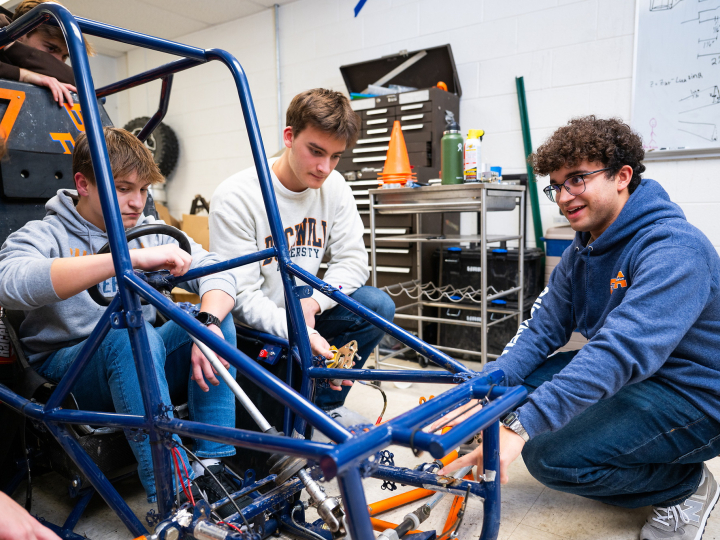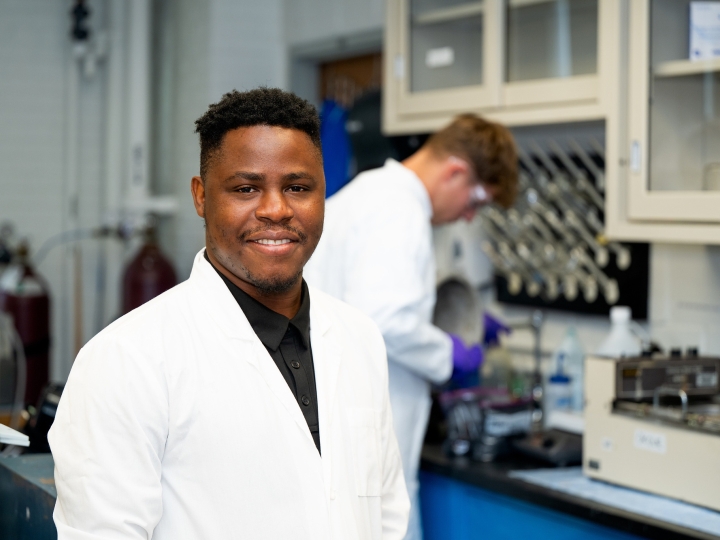Bold Relief
January 19, 2015
Talk to any of the 18 Bucknell University engineering sophomores who spent part of their winter break on campus as participants in the KEEN Winter Interdisciplinary Design Experience, or K-WIDE and chances are they'll each have a different take on the program — this year's theme, which is disaster relief; the cool lab equipment they get to use; the experience of working in teams with different engineering majors.
But one part of their stories will undoubtedly have one thing in common. They will all testify that the most rewarding part of K-WIDE is also the most challenging and it comes at the very beginning of the week-and-a-half-long process.
It's the brainstorming.
"Most of the trouble we had was with the creation of the idea itself," explained Andre Amirsaleh '17, computer science. "We originally wanted to make a sustainable latrine, but Bill Gates just invested in a high-tech GPS version that's unbeatable."
"We had a lot of problems brainstorming ideas," agreed Henry Stann '17, biomedical engineering. "We got frustrated at times with what problem we wanted to focus on."
Professors Joseph Tranquillo, biomedical and electrical engineering and Charles Kim, mechanical engineering, weren't surprised.
"When we say brainstorming in K-WIDE, it is much more than just coming up with ideas," said Tranquillo. "It is about finding unrecognized opportunities for impact. It is about learning more about the market for a product that could make the impact. It is about knowing who the customers are and what their pains are. So for every idea, there is a lot of going back to the drawing board.
We're using this immersive experience to get students to embrace mindsets that will stretch them as designers, value creators and leaders in engineering."
Beaten to the punch by Bill Gates, Amirsaleh's team shifted its focus. "We started thinking about how after a disaster, people form refugee camps," said his teammate Xiaoying Pu '17, computer science & engineering. "One thing we noticed is that there would be security issues. There are usually latrine facilities outside the camp and when women or weaker people use them at night, they would be vulnerable."
Their solution? A solar-powered alarm system. "It provides power to illuminate the area in and around the latrines," said Pu. "And if there is an emergency there will be a panic button to press that sets off a red light and a siren to call for help."
K-WIDE, year three
Funded by a grant from the Kern Family Foundation and support from the Robert F. Sykes Engineering Endowment, K-WIDE brings together engineering sophomores from different disciplines in an intense design process that begins with developing a high-level concept and continues through building a final prototype — for no credit or pay. This year for the first time, Bucknell also invited four students from the South Carolina Governor's School for the Arts & Humanities and their instructor to join part of the K-WIDE experience.
The first K-WIDE program involved restoring and improving urban infrastructure; in the second, students tackled problems related to human weight.
Each teammate brings their own set of skills to the project. "For a while I didn't think I'd have much to contribute and then we got solar panels. I felt useful all of a sudden," smiled Matthew Hawkins '17, computer engineering.
His team designed a glow-in-the-dark survival kit that includes solar panels for charging lights, storage space for medical supplies, USB ports, even a slide-out grill.
"We used my major in things like the dimension of the box," said teammate Annmarie Mullen '17, biomedical engineering. "We wanted to design the handle so the average human hand can hold it. That's something you wouldn't think you'd need biomedical engineering for, but there are actually calculations you can do and accepted averages you can use to design with that in mind."
"The I in K-WIDE is for interdisciplinary," said Kim. "On a surface level all of the teams are composed of different engineering disciplines. So they are technically diverse. But on a much deeper level they are all struggling with all of the complexities that surround the practice of engineering — ethical dilemmas, social problems, individual psychology, market segmentation, packaging, sustainability. All of these come up naturally during the course of the program and are topics that good practicing engineers need to include in their designs."
Despite the frustration they experienced, the students know it's part of the learning process. Mullen said it's also part of what makes K-WIDE great.
"A program like this gives you the opportunity to practice engineering in a completely different way," she explained. "You don't have to worry about grades or getting other schoolwork done — things that can really stifle your creativity. This allows you to think a lot more, take more time. You practice skills that you learn in class, but also learn new ones."

